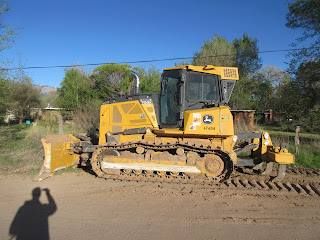Last night at the UV lights I noticed the midges are coming back. There was also one mosquito. The spider population was way down, but I noticed the large ants are as feisty as ever in the pear tree.
Of course, they are also feisty on the ditch banks. Many species are very protective of their ground nests. There have been a few times lately when I have been standing on a ditch bank looking at some frog, and I look down and see a seething mass of ants boiling up out of the ground and up my leg, The bite of some of these ants can leave quite a welt, so check where you are standing! You have been warned!
The activities of the MRGCD (Mid Rio Grande Conservancy district) is getting more serious. This mighty clanker was being used to stabilize the ditch bank at the end of Andrews Lane, though job
Of course, some plants and animals might suffer, but the critters along the ditch are the ones "preadapted" to live through periods of drastic change. Like this duckweed. This weird little plant grows rapidly in the nitrate rich waters. It is red when young and a vibrant green when older. It is an actual plant, not algae. It has leaves and a root, unlike the snotweed that produces filaments.This plant can crowd out other plants and collects in areas of still water. I acts as a sponge and clears the water of bacteria and snotweed by depriving the water of sunlight. Also, in the winter the biomass sinks and rots, clearing the water of oxygen and keeping out the fish, wonderful for frogs and other invertebrate critters.
These mallards cover a small territory and eat the plants both snotweed and duckweed, as well as the small critters hiding in those plants, like amphipods. Their activities keep patches of water clear and their trails through the weeds allow fish and turtles easier access. The prefer areas near tree cover, presumably to protect from raptors. shaded areas of water also have less cattails growing in them, and tend to have deeper areas of water.




No comments:
Post a Comment